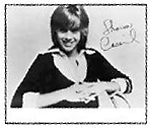On television, sometimes a spin-off proves just as enduring as the series that spawned it. But when Tina Weymouth and Chris Frantz inaugurated the band Tom Tom Club, they had no idea this wacky-as-Rhoda counterpart to the serious-as-Mary quartet that spawned it—Talking Heads—would take on such a long life of its own.
After an eight-year hiatus, Weymouth and Frantz return with a new incarnation of Tom Tom Club on The Good, the Bad and the Funky (Rykodisc), featuring 14 fresh reggae-, funk-, and ska-flavored tracks, infused with the sunny, free-spirited vibe that helped their eponymous 1981 debut achieve gold sales status.
In addition to simply missing making music, Weymouth says one factor that prompted the husband-and-wife rhythm section to resurrect Tom Tom Club was “that everybody was sampling us. And we said, ‘Hey, maybe we better make some more music they can sample.'” Over the past two decades, TTC tunes have been borrowed by a plethora of artists, including Ziggy Marley, Puff Daddy (oh, there’s a surprise), and Grandmaster Flash. The band’s 1982 Top 40 hit, “Genius of Love,” is a particular favorite; Mariah Carey used the track to anchor her 1995 smash “Fantasy.”
But Weymouth’s not complaining about the royalties: “Certainly Mariah is what paid for us to be able to make for this album.” Still, the bassist wishes the chart-topping diva had simply covered the original song. “That’s what I always hope for when we’re writing these songs—that someone really good will do it justice.”
Wait a minute. The light-hearted vocals of Tina—and, on early albums, her sisters Lani and Laura—are part of what makes Tom Tom Club so endearing. “That’s very kind of you,” she replies demurely. “One must work with one’s limitations.”
“I became a singer by default,” she adds. “We had a wonderful singer, but he decided to go off and do his solo thing.”
Ouch. She’s referring to the schism between Talking Heads founder David Byrne and the other three members. Until the final dissolution of Talking Heads in 1995, periods of activity for Tom Tom Club typically correlated with stretches when Frantz and Weymouth’s other band was sidelined by Byrne’s solo commitments.
In a bizarre twist, Byrne also played a role in the genesis of The Good, the Bad and the Funky. Originally, the plan was to assemble a Tom Tom Club greatest-hits package. Meanwhile, Byrne was busy with a nostalgic project of his own. “He wanted to rerelease Stop Making Sense to remind everybody what a superstar he was,” says Weymouth. Without telling Tom Tom Club, he cleaned up the film’s version of “Genius of Love,” to include on the revamped soundtrack CD. When the couple caught wind, they told him he couldn’t use the song, since their compilation was slated for release around the same time.
Byrne, Weymouth alleges, pulled strings at Warner Bros.—home to Byrne’s solo work, the Talking Heads catalog, and Tom Tom Club at the time—to get his way. “Within two days, we didn’t have a deal anymore,” she sighs. “But it’s no great loss, because instead we went and did this album.”
The group’s fifth full-length, the new disc is their most musically diverse yet. The first single, “Who Feelin’ It,” name-checks everyone from James Brown and Manu Dibango to the Invisbl Skratch Pklz and Wu-Tang Clan. In addition to a frothy cover of Donna Summer’s “Love to Love You Baby,” the disc also features a version of dub pioneer Lee “Scratch” Perry’s “Soul Fire.”
“Lee Perry was as big an influence for me as James Brown,” says Weymouth. During her formative listening years, she fell in love with “the wide open spaces” of his music. “It’s got its head in the clouds, but the feet are definitely on the ground. It’s always got great drums and bass, and then everything else—including the vocals—is [engineered] to make those things sound good.”
Space plays an important role in Tom Tom Club’s compositional process, too. “Because we see [a song] as having a depth of field, the way a picture does. . . . Some things are in focus, directly in the middle, and other things will be stereo left or right, and either forwards or backward, depending on where we want to place them. And whether you play staccato or legato, it’s like the stroke of a pen or a brush.”
Weymouth admits that collaborators—including teenage turntablist Kid Ginseng, Toots Hibbert of Toots and the Maytals, P-funk legend Bernie Worrell, and Senegalese composer Abdou M’Boup this time out—are often baffled when she and Frantz discuss the music in visual terms. But she views that as a plus.
“I love the way people sometimes misunderstand. It’s like when you’re learning how to play music, and you don’t really understand what this really great artist has done, and you’re trying to write a song like them, so you do it all wrong, but then you come up with something brand new as a result.”






